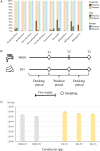Tap water as a natural vehicle for microorganisms shaping the human gut microbiome
- PMID: 35355372
- PMCID: PMC9790288
- DOI: 10.1111/1462-2920.15988
Tap water as a natural vehicle for microorganisms shaping the human gut microbiome
Abstract
Fresh potable water is an indispensable drink which humans consume daily in substantial amounts. Nonetheless, very little is known about the composition of the microbial community inhabiting drinking water or its impact on our gut microbiota. In the current study, an exhaustive shotgun metagenomics analysis of the tap water microbiome highlighted the occurrence of a highly genetic biodiversity of the microbial communities residing in fresh water and the existence of a conserved core tap water microbiota largely represented by novel microbial species, representing microbial dark matter. Furthermore, genome reconstruction of this microbial dark matter from water samples unveiled homologous sequences present in the faecal microbiome of humans from various geographical locations. Accordingly, investigation of the faecal microbiota content of a subject that daily consumed tap water for 3 years provides proof for horizontal transmission and colonization of water bacteria in the human gut.
© 2022 The Authors. Environmental Microbiology published by Society for Applied Microbiology and John Wiley & Sons Ltd.
Figures



Similar articles
-
Microbial species from multiple maternal body sites shape the developing giant panda (Ailuropoda melanoleuca) cub gut microbiome.Mol Ecol. 2023 May;32(9):2271-2286. doi: 10.1111/mec.16869. Epub 2023 Feb 12. Mol Ecol. 2023. PMID: 36722794
-
Associations between UK tap water and gut microbiota composition suggest the gut microbiome as a potential mediator of health differences linked to water quality.Sci Total Environ. 2020 Oct 15;739:139697. doi: 10.1016/j.scitotenv.2020.139697. Epub 2020 May 26. Sci Total Environ. 2020. PMID: 32758933
-
Drinking Water Source and Intake Are Associated with Distinct Gut Microbiota Signatures in US and UK Populations.J Nutr. 2022 Jan 11;152(1):171-182. doi: 10.1093/jn/nxab312. J Nutr. 2022. PMID: 34642755 Free PMC article.
-
Structural diversity and functional variability of gut microbial communities associated with honey bees.Microb Pathog. 2020 Jan;138:103793. doi: 10.1016/j.micpath.2019.103793. Epub 2019 Oct 15. Microb Pathog. 2020. PMID: 31626917 Review.
-
Microorganisms populating the water-related indoor biome.Appl Microbiol Biotechnol. 2020 Aug;104(15):6443-6462. doi: 10.1007/s00253-020-10719-4. Epub 2020 Jun 12. Appl Microbiol Biotechnol. 2020. PMID: 32533304 Free PMC article. Review.
Cited by
-
Metagenomic Analysis of Surface Waters and Wastewater in the Colombian Andean Highlands: Implications for Health and Disease.Curr Microbiol. 2025 Feb 28;82(4):162. doi: 10.1007/s00284-024-04019-7. Curr Microbiol. 2025. PMID: 40021498 Free PMC article.
-
Case report: contamination of a drinking water distribution system by Exophiala-dominated biofilm in the Midwestern United States.J Water Health. 2025 Mar;23(3):314-321. doi: 10.2166/wh.2025.173. Epub 2025 Feb 7. J Water Health. 2025. PMID: 40156210
-
Microbiome characterization of alpine water springs for human consumption reveals site- and usage-specific microbial signatures.Front Microbiol. 2022 Oct 5;13:946460. doi: 10.3389/fmicb.2022.946460. eCollection 2022. Front Microbiol. 2022. PMID: 36274724 Free PMC article.
References
-
- Bowyer, R.C.E. , Schillereff, D.N. , Jackson, M.A. , Le Roy, C. , Wells, p.M. , Spector, T.D. , and Steves, C.J. (2020) Associations between UKtap water and gut microbiota composition suggest the gut microbiome as a potential mediator of health differences linked to water quality. Sci Total Environ 739: 139697. - PubMed
-
- Busse, H.J. , Denner, E.B.M. , Buczolits, S. , Salkinoja‐Salonen, M. , Bennasar, A. , and Kämpfer, P. (2003) Sphingomonas aurantiaca sp. nov., Sphingomonas aerolata sp. nov. and Sphingomonas faeni sp. nov., air‐ and dustborne and Antarctic, orange‐pigmented, psychrotolerant bacteria, and emended description of the genus Sphingomonas. Int J Syst Evol Microbiol 53: 1253–1260. - PubMed
Publication types
MeSH terms
Substances
LinkOut - more resources
Full Text Sources
Medical
Miscellaneous

